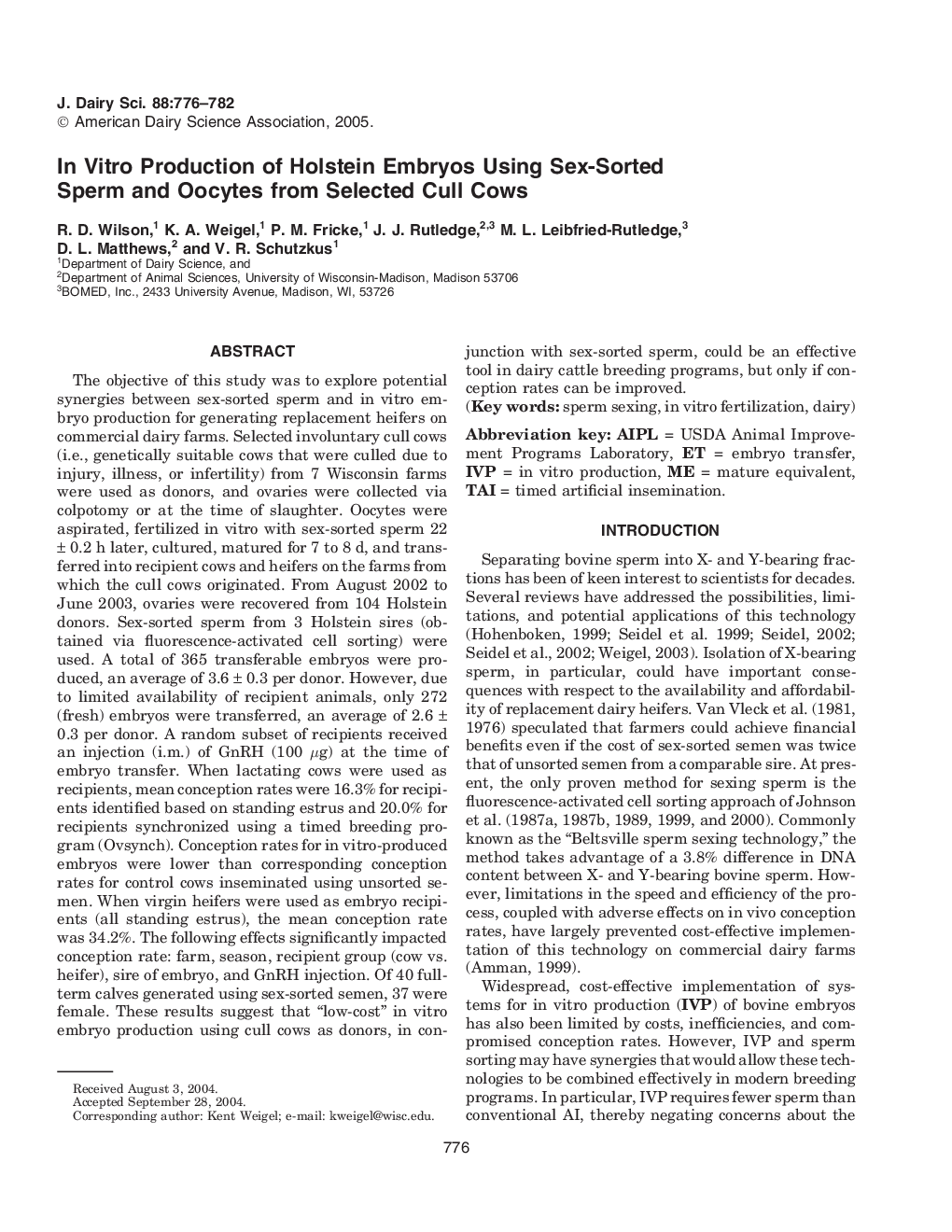| کد مقاله | کد نشریه | سال انتشار | مقاله انگلیسی | نسخه تمام متن |
|---|---|---|---|---|
| 8981198 | 1108143 | 2005 | 7 صفحه PDF | دانلود رایگان |
عنوان انگلیسی مقاله ISI
In Vitro Production of Holstein Embryos Using Sex-Sorted Sperm and Oocytes from Selected Cull Cows
دانلود مقاله + سفارش ترجمه
دانلود مقاله ISI انگلیسی
رایگان برای ایرانیان
کلمات کلیدی
موضوعات مرتبط
علوم زیستی و بیوفناوری
علوم کشاورزی و بیولوژیک
علوم دامی و جانورشناسی
پیش نمایش صفحه اول مقاله

چکیده انگلیسی
The objective of this study was to explore potential synergies between sex-sorted sperm and in vitro embryo production for generating replacement heifers on commercial dairy farms. Selected involuntary cull cows (i.e., genetically suitable cows that were culled due to injury, illness, or infertility) from 7 Wisconsin farms were used as donors, and ovaries were collected via colpotomy or at the time of slaughter. Oocytes were aspirated, fertilized in vitro with sex-sorted sperm 22 ± 0.2 h later, cultured, matured for 7 to 8 d, and transferred into recipient cows and heifers on the farms from which the cull cows originated. From August 2002 to June 2003, ovaries were recovered from 104 Holstein donors. Sex-sorted sperm from 3 Holstein sires (obtained via fluorescence-activated cell sorting) were used. A total of 365 transferable embryos were produced, an average of 3.6 ± 0.3 per donor. However, due to limited availability of recipient animals, only 272 (fresh) embryos were transferred, an average of 2.6 ± 0.3 per donor. A random subset of recipients received an injection (i.m.) of GnRH (100 μg) at the time of embryo transfer. When lactating cows were used as recipients, mean conception rates were 16.3% for recipients identified based on standing estrus and 20.0% for recipients synchronized using a timed breeding program (Ovsynch). Conception rates for in vitro-produced embryos were lower than corresponding conception rates for control cows inseminated using unsorted semen. When virgin heifers were used as embryo recipients (all standing estrus), the mean conception rate was 34.2%. The following effects significantly impacted conception rate: farm, season, recipient group (cow vs. heifer), sire of embryo, and GnRH injection. Of 40 full-term calves generated using sex-sorted semen, 37 were female. These results suggest that “low-cost” in vitro embryo production using cull cows as donors, in conjunction with sex-sorted sperm, could be an effective tool in dairy cattle breeding programs, but only if conception rates can be improved.
ناشر
Database: Elsevier - ScienceDirect (ساینس دایرکت)
Journal: Journal of Dairy Science - Volume 88, Issue 2, February 2005, Pages 776-782
Journal: Journal of Dairy Science - Volume 88, Issue 2, February 2005, Pages 776-782
نویسندگان
R.D. Wilson, K.A. Weigel, P.M. Fricke, J.J. Rutledge, M.L. Leibfried-Rutledge, D.L. Matthews, V.R. Schutzkus,